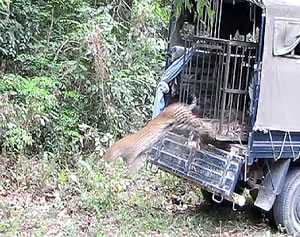In local parlance, the Caracal is called ‘Siyagosh’ meaning ‘black ear’. It is an ode to the black tuft of hair peaking on the two ears of this wild cat. They act like antennae, picking up distant and minute vibrations. For the Caracal they are one of the many characteristics adapted to survive in the dry, arid regions of the country and what makes them distinct from other wild cats found in India such as the tigers or leopards. Rarely seen, less often heard, a new study has estimated that there are between 18 to 35 Caracals in Ranthambore National Park.
The study was conducted by a team led by Manoj Parashar, Field Director of Ranthambore National Park by monitoring the movement of the cats using camera traps between January and April 2020.
Also read: Caracal spotted in Bharatpur Bird Sanctuary for the first time
“It was decided that we will process our camera trap capture data to initiate some population estimation exercise and arrive at an estimate of the individual present in the area. Due to the presence of tigers outside the reserve, especially in Dholpur, Karauli and Bundi, camera trap data of these areas could be included,” says Parashar.
In Ranthambore, he adds, there are seven species of wild cats of which the caracal is the rarest and least known in terms of status and ecology.
While this comes as no surprise that data related to the caracal is rare when most focus and funds are reserved for the tiger, what is interesting is that historically, the caracal was a celebrated beast, especially among the royalties.
Tamed for hunting
Centuries ago, when Maharajahs ruled the lands of Rajasthan, Delhi, Uttar Pradesh, Gujarat, Punjab and Haryana, the caracal or siyagosh were tamed and used for hunting. In ancient Egypt there was a practice to tame these wild cats too.
According to Divyajyoti Ganguly writing for Conservation India, over the decades, the caracal has earned many names throughout its local range in India which span from Rajasthan and Kutch in the west to Uttar Pradesh in the east, and also South Africa, and the Arabic Peninsula outside of India. Called Rooicat in South Africa, ‘Quora-Qulaq’ (Black ears) in Arabic, ‘Harnotro’ (Killer of blackbucks) in Kachhi, ‘Mour Maar Baghera’ (Peacock killing wild cat) in Rajasthani and of course Siya Gosh in Persian and Hindi, the caracal had quite the reputation.

It is said that even though it was kept chained under royal service, this wild species could never really be tamed. Very agile, extremely dextrous, super-sensitive ears with 20 different muscles independently controlling the motion of each ear, these cats are custom-built to run, leap, and hunt small rodents to flying birds and leaping blackbucks. The caracal can actually jump 3 metre up in the air and stalk prey on paws shaped like the cheetah.
Early naturalists called the caracal a ‘Red Lynx’. It is now known that it is one of the 27 extant species of small cats found worldwide and is not a lynx but has its own lineage. Since 1972 there is no published record of the number of Caracals in India. It is assumed that with dry, arid regions began to be inhabited by humans and given the animal’s intolerance towards humans, the species numbers began to decrease.
While the International Union for Conservation of Nature (IUCN) lists the caracal as a ‘Least Concern’ animal, in India it has been accorded the same level of protection as the tiger under the Wildlife Protection Act of 1972. A 2009 population estimate suggested 10 caracals in Kutch and the present one shows a sizable population in the Ranthambore National Park.
Threats to the caracal
- Habitat loss is the single most prominent threat as the caracal is very sensitive to modification and human presence.
- Wind factories in Kutch, as well as mining of lignite, limestone, and bentonite
- Caracal habitat outside of protected areas is considered wasteland though vital for the animal’s survival. By marking a land as a wasteland, it is easier to acquire it for development projects and agriculture.
- Illegal wildlife trade. In 2017, five caracals were rescued in Mirzapur, Uttar Pradesh while being taken to be sold as exotic pets. Caracal skin is also a high demand product.
- Vehicle collision on the number of highways built across the caracal habitat
- Mauling by feral dogs









